by Kammy Kern-Korot, senior conservationist
Emerald Ash Borer
The emerald ash borer and Mediterranean oak borer are insect pests that pose significant threats to Oregon’s native tree populations. Neither bug originates in North America and they are expected to have an outsized negative impact on tree species that are crucial to our ecosystems. Their arrivals in Oregon necessitate vigilant monitoring and community involvement to slow their spread and limit their impact.
The emerald ash borer (EAB), a non-native beetle whose spread is enabled by people moving firewood, has already caused significant destruction to ash trees on the East Coast and in the Midwest. It was first detected in Oregon in Washington County in 2022 and has been spreading. It has since been found in neighboring counties.
EAB is known for devastating ash trees like the native Oregon ash (Fraxinus latifolia), which is a widespread and important tree species in riparian areasRiparian areas The land alongside a stream, creek, river, or floodplain and forested wetlands. EAB presence has prompted a coordinated response statewide. The Oregon Emerald Ash Borer Task Force, spearheaded by the Oregon departments of Forestry (ODF) and Agriculture (ODA), coordinates efforts to track and slow the beetle’s spread. Within 15 miles of the infestation, local teams actively participate in surveying and monitoring efforts.
West Multnomah SWCD continues to participate in monthly task force meetings to share resources, information, and strategies. In May 2024, the district deployed eight EAB traps at seven rural project sites and properties on the District’s western edge and in ash tree-rich areas. Traps are deployed during the summer. Staff inspect traps either bi-weekly or every 60 days, record and share results, and do additional monitoring of ash trees using ODA survey tools.
Trapping the Beetle and More
In spring 2024, WMSWCD switched some of our green funnel traps, which catch target insects in liquid placed in the receptacle below the lowest funnel, to sticky purple prism traps, since they require less servicing. And, we added two new sites—one at another wetland restoration site along the Willamette River and one on private land at a site near Tryon Creek State Park—in lieu of two sites where we had traps in past years. Our two 2024 seasonal interns have been invaluable in consistently (bi-weekly) maintaining the traps and checking for suspect insects. As we get out to more and more sites, we are identifying additional valuable ash tree stands and locations to monitor.
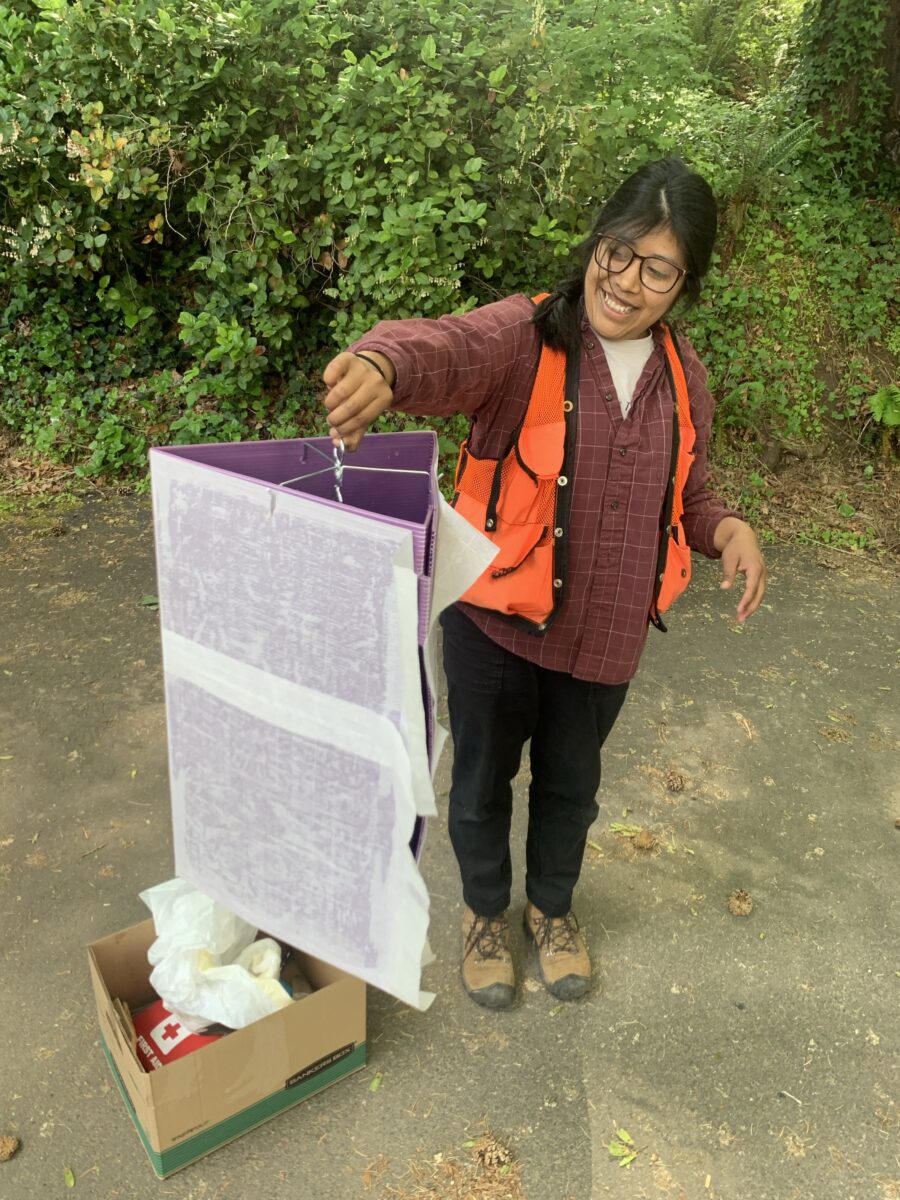
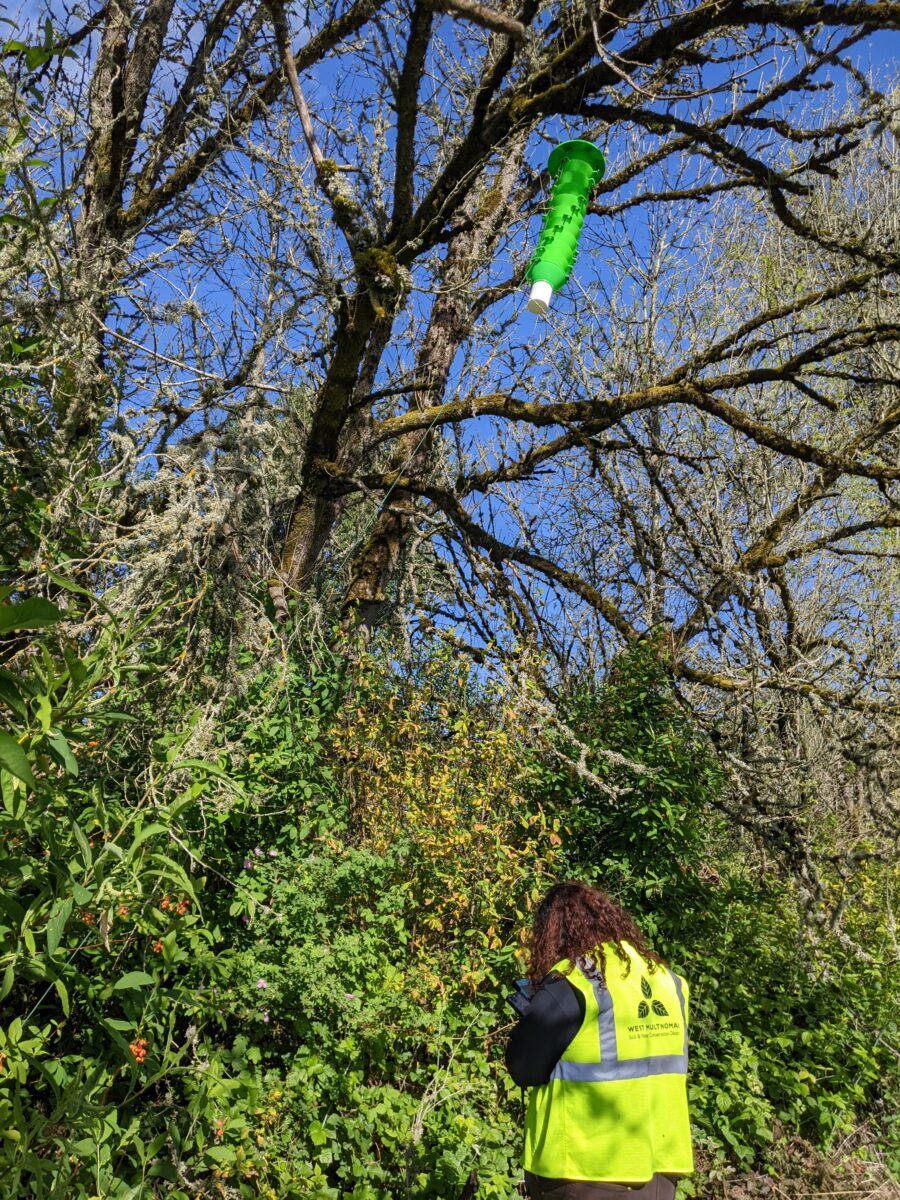
An intern records data after checking a green funnel trap.
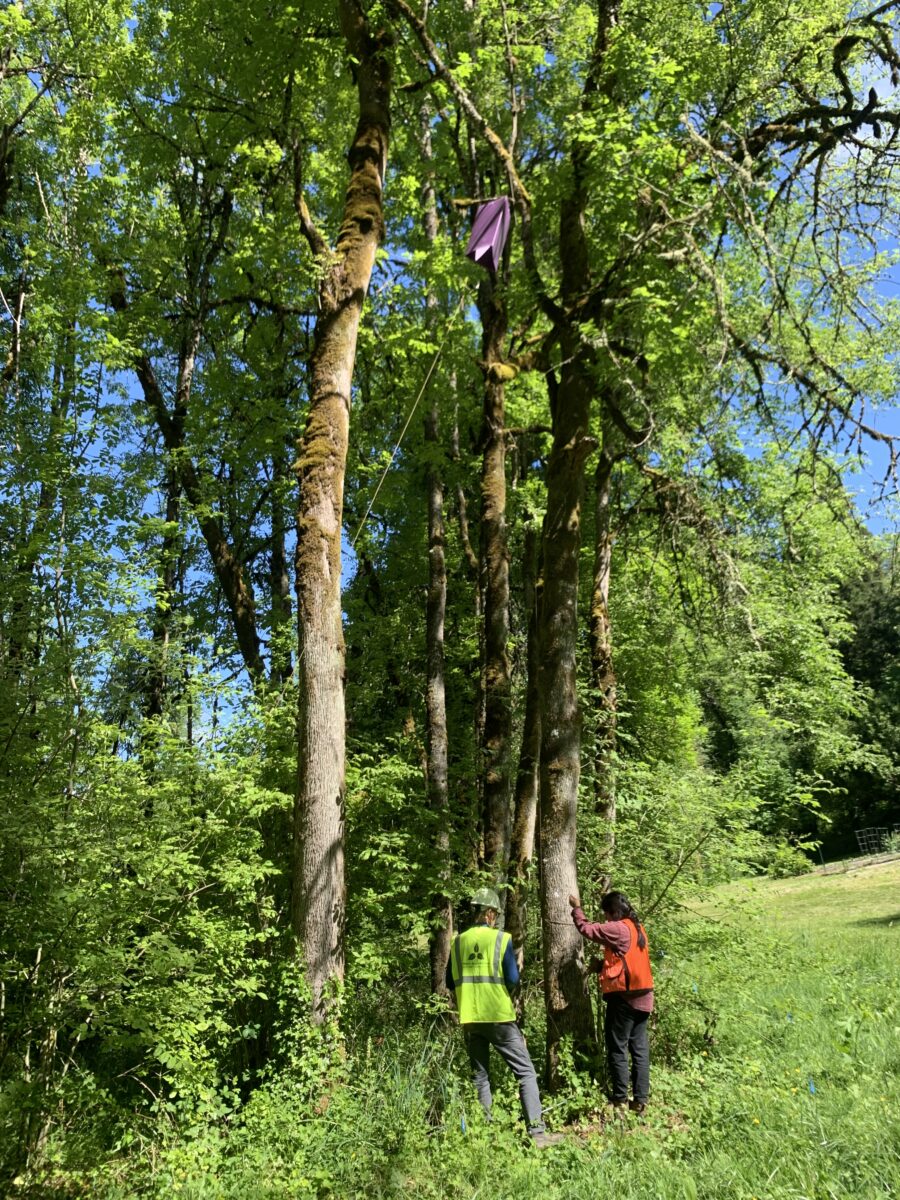
Intern and staff hoist purple prism trap into tall ash tree in SW Portland.
Federal, state and local partners supplement monitoring for EAB via insect traps with various containment tactics learned from the East Coast and/or innovated here in Oregon. Actions include the creation of “trap trees” (i.e., a girdled ash tree, which emits a scent), which attract EAB, and injection of nearby ash trees with insecticides that kill the EAB; plus the targeted release of parasitoid wasps—all aimed at slowing the spread of EAB from the infested areas.
Community Education and Research
District staff are educating community members on how to detect and prevent new infestations of EAB. The most important lesson is “Don’t move firewood!” District outreach includes one-on-one information-sharing during site visits and over the phone, on our website, via our local partners, and at multiple community events (will link).
This year, we worked with researchers at Oregon State University (OSU) and the U.S. Forest Service (USFS) to identity sites suitable for Oregon ash genetic research. The effort uses grant funds from USFS to plant ash seedlings from different native ash populations on the Northwest Coast and test for any resistance to EAB over the coming years. The goal is to have three to five ash “plantation” or study sites close to the current extent of Oregon’s EAB infestations and where we expect them to be in the near future.
Swapping Ash for Alder
Another way we are responding to the arrival of EAB in Oregon is looking for substitute tree species to plant, instead of adding more ash, that could be doomed by EAB. There is no true substitute for the ecological niche that Oregon ash fills, as it often grows in heavy, poorly drained soils suitable for few other species and is a very long-lived tree. We are not recommending people get rid of healthy ash, but rather the swap is for new plantings. Still, we are experimenting with planting white alder in areas with or near existing Oregon ash.
White alder (Alnus rhombifolia) is a Willamette Valley native tree species that is more prevalent in Southern Oregon, as compared to red alder (A. rubra), which is well-represented thoughout Western Oregon. Studies show white alder surviving better with climate change than red alder and some other trees species we typically plant.
So, in early 2024, the District gave away and planted 3,600 white alders at 36 different sites in a variety of sun, moisture, and drainage conditions. This strategy is in response to both our changing climate and the risks of EAB. By planting and monitoring the survival and vigor of our seedlings in such a range of sites and conditions, we aim to refine our understanding of where they may best succeed.
Help You Can Help Slow the Spread of EAB:

- Don’t move firewood!
- Learn to identify ash trees
- Map ash tree locations in Oregon at https://www.inaturalist.org/projects/oregon-ash-survey-oregon
- Learn to recognize signs of EAB and report suspects to OregonInvasivesHotline.org
Mediterranean Oak Borer
Meanwhile, in 2024 the Mediterranean oak borer (MOB) was discovered to have infested more than 30 oak trees in the North Willamette Valley, after initial sightings in earlier years in traps and one or two oak trees, including in Multnomah County. MOB poses yet another serious threat to our local ecosystems and tree canopy. This tiny beetle bores into the trunk of oak trees and brings with it a fungus that spreads a disease, sometimes known as “oak wilt,” which, more often than not, kills the trees.
Of particular concern is our culturally and ecologically significant Oregon white oaks (Quercus garryana), which have been the victims of MOB. In response to this unwelcome invasive insect’s arrival, the District has supported ODF and ODA’s monitoring for MOB by adding a black MOB trap with its own distinct lure to the small fleet of EAB traps that we were already deploying.
Help Us Stop the MOB:
- Learn to recognize Oregon white oak trees
- Learn to recognize the signs of MOB
- Map any mature oak trees you find on iNaturalist.
- Don’t move firewood and only move treated wood! It is crucially important to prevent the introduction of the MOB to new areas. If you use firewood, buy and/or use it within 10 miles of harvest location. Only move firewood and wood pallets that have been heat-treated and certified as pest-free.
- Finally, if you spot an oak with dying branches and frass / sawdust on or at the base of the trunk, report it to OregonInvasivesHotline.org.
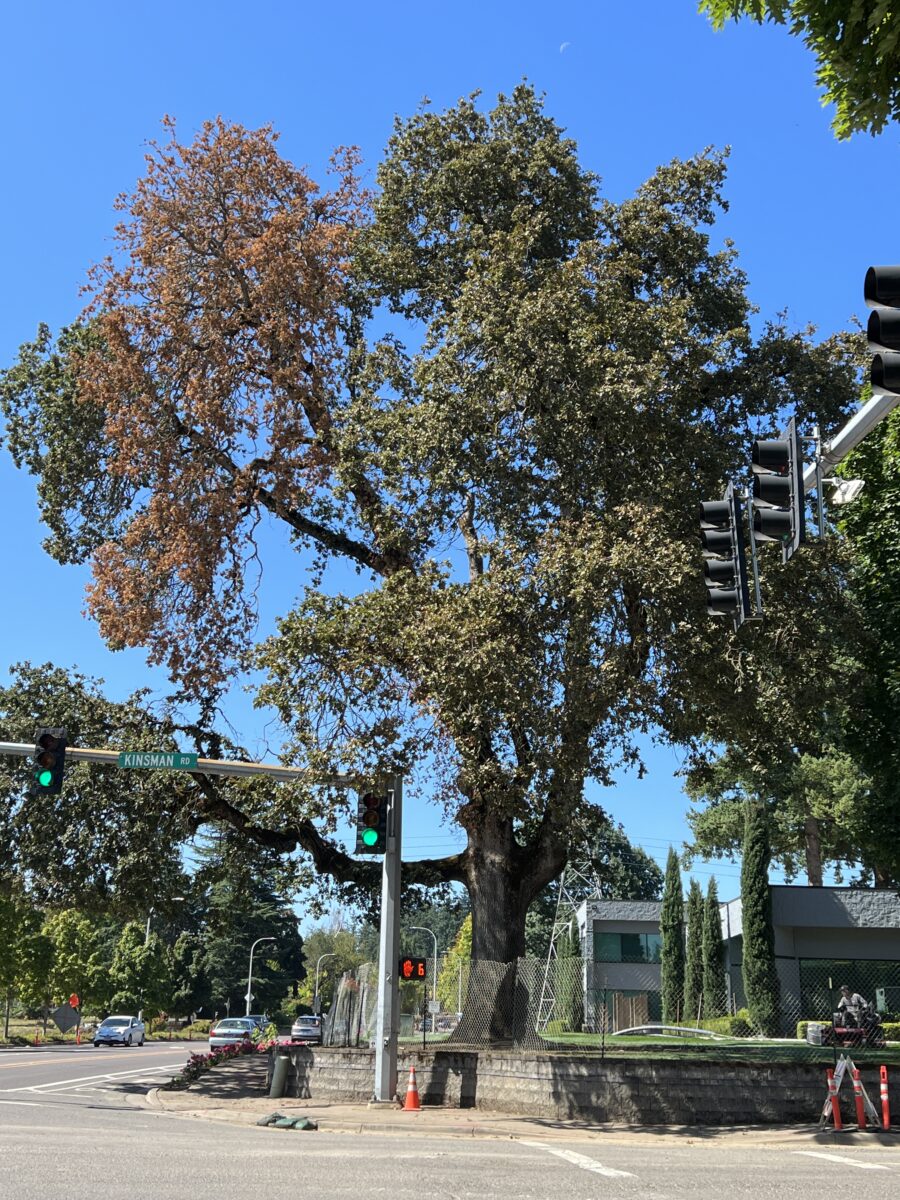
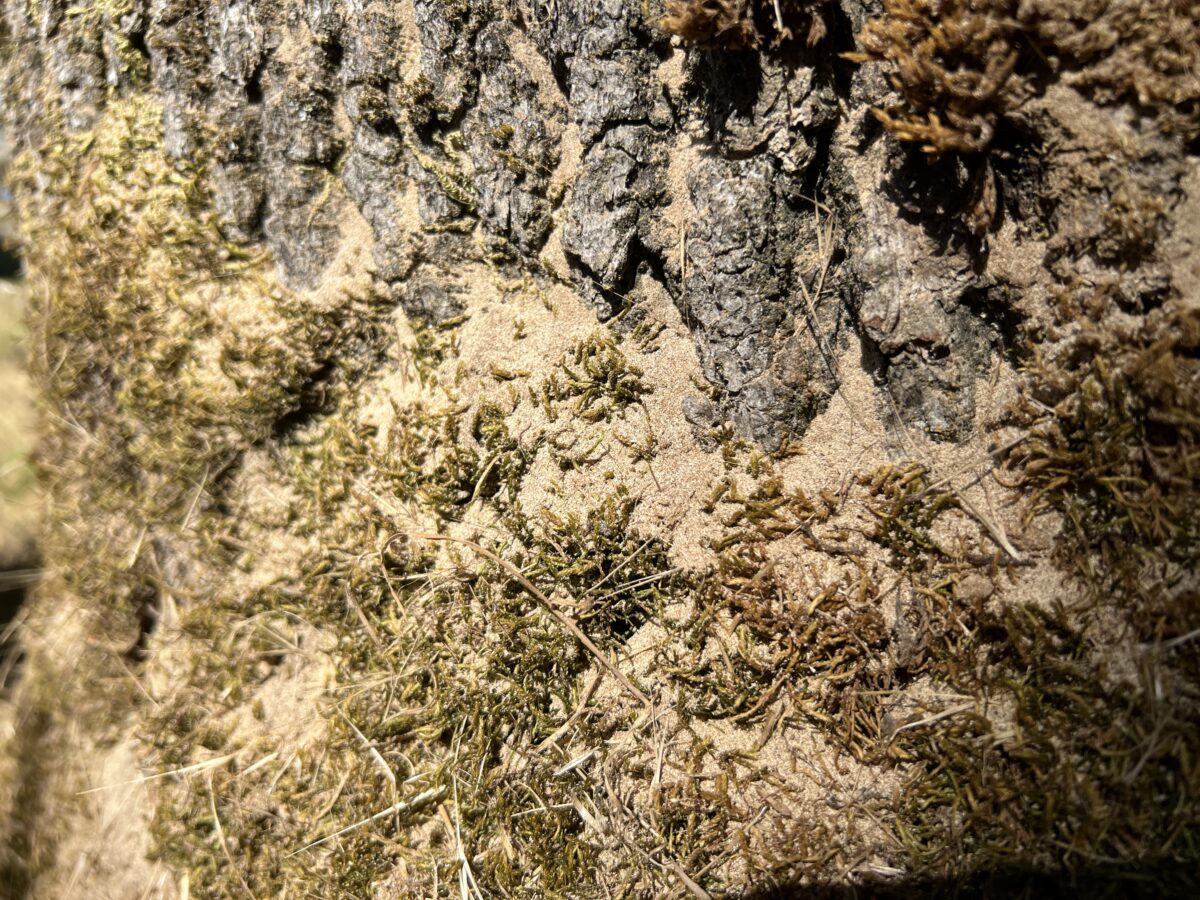
For landowners with Oregon ash or Oregon white oak trees, our conservationists can assist in planning for habitat resilience and enhancement. And, by educating your friends and family about the seriousness of the invasive insect threat we face and how they can join our efforts to save our precious ash and oak trees, you can be part of the solution!